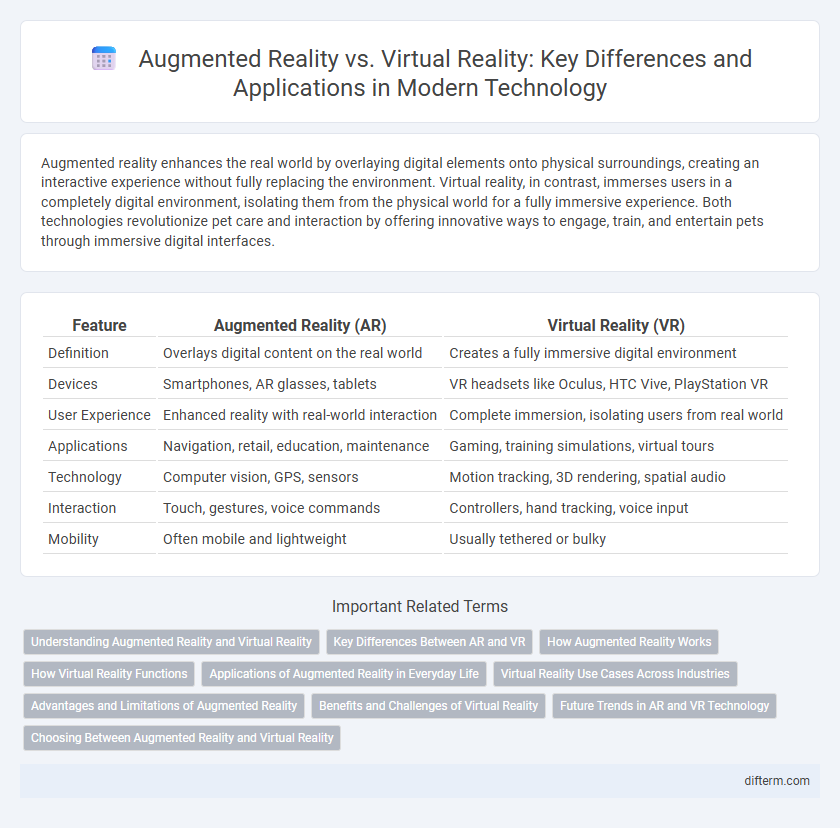Augmented reality enhances the real world by overlaying digital elements onto physical surroundings, creating an interactive experience without fully replacing the environment. Virtual reality, in contrast, immerses users in a completely digital environment, isolating them from the physical world for a fully immersive experience. Both technologies revolutionize pet care and interaction by offering innovative ways to engage, train, and entertain pets through immersive digital interfaces.
Table of Comparison
| Feature | Augmented Reality (AR) | Virtual Reality (VR) |
|---|---|---|
| Definition | Overlays digital content on the real world | Creates a fully immersive digital environment |
| Devices | Smartphones, AR glasses, tablets | VR headsets like Oculus, HTC Vive, PlayStation VR |
| User Experience | Enhanced reality with real-world interaction | Complete immersion, isolating users from real world |
| Applications | Navigation, retail, education, maintenance | Gaming, training simulations, virtual tours |
| Technology | Computer vision, GPS, sensors | Motion tracking, 3D rendering, spatial audio |
| Interaction | Touch, gestures, voice commands | Controllers, hand tracking, voice input |
| Mobility | Often mobile and lightweight | Usually tethered or bulky |
Understanding Augmented Reality and Virtual Reality
Augmented Reality (AR) enhances the real world by overlaying digital content through devices like smartphones and smart glasses, enabling users to interact with virtual elements within their physical environment. Virtual Reality (VR) immerses users in a completely digital environment using headsets such as the Oculus Rift or HTC Vive, isolating them from the actual surroundings for an interactive experience. Both technologies leverage advanced sensors, computer vision, and graphics processing to create engaging and immersive digital experiences for applications in gaming, education, and industry.
Key Differences Between AR and VR
Augmented reality (AR) overlays digital content onto the real world, enhancing user interaction without fully replacing their surroundings, while virtual reality (VR) immerses users in a completely simulated environment through devices like VR headsets. AR applications commonly include real-time navigation, retail visualization, and maintenance support, leveraging mobile devices and smart glasses, whereas VR focuses on gaming, training simulations, and virtual tours using dedicated headsets. The fundamental difference lies in AR blending digital elements with reality, whereas VR creates a fully artificial experience, impacting hardware requirements and user engagement.
How Augmented Reality Works
Augmented Reality (AR) works by overlaying digital information onto the physical world using devices like smartphones, tablets, or AR glasses equipped with cameras and sensors. These devices capture the real environment, process spatial data, and render interactive 3D models or graphics that align with the user's view in real time. Unlike Virtual Reality, which creates a fully immersive digital environment, AR enhances the real world by adding contextual digital elements without replacing the user's surroundings.
How Virtual Reality Functions
Virtual Reality (VR) functions by creating fully immersive digital environments using head-mounted displays, motion sensors, and spatial audio. It tracks users' movements to adjust the visual and auditory experience in real-time, enhancing the sensation of presence within a simulated space. Advanced VR systems employ technologies such as LCD or OLED screens, gyroscopes, and accelerometers to deliver realistic, interactive virtual worlds.
Applications of Augmented Reality in Everyday Life
Augmented reality (AR) enhances everyday experiences by overlaying digital information onto the real world, revolutionizing sectors like retail, education, and healthcare. In retail, AR enables virtual try-ons and interactive product displays, improving customer engagement and decision-making. Educational applications use AR to create immersive, hands-on learning experiences, while healthcare benefits from AR-assisted surgeries and patient rehabilitation tools.
Virtual Reality Use Cases Across Industries
Virtual Reality (VR) technology revolutionizes industries such as healthcare, enabling immersive surgical training and patient therapy simulations, and education by delivering interactive virtual classrooms that enhance learning engagement. In manufacturing, VR streamlines product design through detailed virtual prototyping, reducing costs and time to market. The entertainment industry leverages VR to create fully immersive gaming and cinematic experiences, driving new levels of user interaction and storytelling.
Advantages and Limitations of Augmented Reality
Augmented reality (AR) enhances real-world environments with digital overlays, enabling users to interact with virtual objects while remaining aware of their surroundings, which offers advantages such as improved situational awareness and practical applications in fields like healthcare, education, and manufacturing. AR's limitations include its reliance on hardware like smartphones or specialized glasses, potential issues with latency and accuracy, and challenges in immersive experience compared to virtual reality (VR). Despite these drawbacks, AR's ability to blend digital information with the physical world provides unique benefits that VR's fully immersive environment may lack.
Benefits and Challenges of Virtual Reality
Virtual reality (VR) offers immersive experiences enhancing training, gaming, and remote collaboration by simulating realistic environments that improve user engagement and skill acquisition. Challenges include high development costs, motion sickness, and the need for powerful hardware, which can limit accessibility and long-term user comfort. Continuous advancements in VR headsets and software optimization aim to overcome these barriers, expanding its applications in education, healthcare, and entertainment.
Future Trends in AR and VR Technology
Future trends in augmented reality (AR) and virtual reality (VR) technology emphasize advancements in spatial computing, increased integration with 5G networks, and the development of more realistic haptic feedback systems. AR will leverage AI-driven real-time data overlays for industries such as healthcare and manufacturing, while VR is progressing towards fully immersive, multi-sensory experiences for education and remote collaboration. Continued miniaturization of hardware and improved battery life will enable widespread adoption across consumer and enterprise markets.
Choosing Between Augmented Reality and Virtual Reality
Choosing between augmented reality (AR) and virtual reality (VR) depends on the intended application and user interaction level; AR overlays digital content onto the real world, enhancing real-world experiences, while VR creates fully immersive digital environments that replace the real world. Industries such as retail and healthcare use AR for interactive training and product visualization, whereas VR is prominent in gaming and simulation-based learning for total immersion. Understanding specific use cases and hardware capabilities guides businesses in selecting the optimal technology for engagement and effectiveness.
Augmented reality vs Virtual reality Infographic

 difterm.com
difterm.com